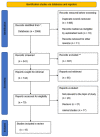Role of First Trimester Screening Biochemical Markers to Predict Hypertensive Pregnancy Disorders and SGA Neonates-A Narrative Review
- PMID: 37685488
- PMCID: PMC10487207
- DOI: 10.3390/healthcare11172454
Role of First Trimester Screening Biochemical Markers to Predict Hypertensive Pregnancy Disorders and SGA Neonates-A Narrative Review
Abstract
Early recognition of high-risk pregnancies through biochemical markers may promote antenatal surveillance, resulting in improved pregnancy outcomes. The goal of this study is to evaluate the possibilities of using biochemical markers during the first trimester of pregnancy in the prediction of hypertensive pregnancy disorders (HPD) and the delivery of small-for-gestational-age (SGA) neonates. A comprehensive search was conducted on key databases, including PubMed, Scopus, and Web of Science, for articles relating to the use of biochemical markers in the prediction of HPD and SGA. The findings show that changes in the levels of biomarkers in the early pregnancy phases could be an important indicator of adverse pregnancy outcomes. The literature shows that low PAPP-A (pregnancy-associated plasma protein A) and PlGF (placental growth factor) levels, low alkaline phosphatase (AP), higher sFlt-1 (soluble fms-like Tyrosine Kinase-1) levels, higher AFP (alfa fetoprotein) levels, and elevated levels of inflammatory markers such as β-HGC (free beta human chorionic gonadotropin), interferon-gamma (INF-γ), and tumor necrosis factor-α (TNF-α) may be associated with risks including the onset of HPD, fetal growth restriction (FGR), and delivery of SGA neonates. Comparatively, PAPP-A and PlGF appear to be the most important biochemical markers for the prediction of SGA and HPD.
Keywords: PAPP-A; PlGF; biochemical markers; high-risk pregnancies; hypertensive disorders in pregnancy; narrative review; small-for-gestational-age.
Conflict of interest statement
The authors declare no conflict of interest.
Figures
Similar articles
-
Prediction of small-for-gestational-age neonates: screening by maternal serum biochemical markers at 19-24 weeks.Ultrasound Obstet Gynecol. 2015 Sep;46(3):341-9. doi: 10.1002/uog.14899. Epub 2015 Aug 6. Ultrasound Obstet Gynecol. 2015. PMID: 25969963 Clinical Trial.
-
Prediction of small-for-gestational-age neonates: screening by maternal biochemical markers at 30-34 weeks.Ultrasound Obstet Gynecol. 2015 Aug;46(2):208-15. doi: 10.1002/uog.14861. Ultrasound Obstet Gynecol. 2015. PMID: 25826797
-
Soluble fms-like tyrosine kinase to placental growth factor ratio in different stages of early-onset fetal growth restriction and small for gestational age.Acta Obstet Gynecol Scand. 2021 Jan;100(1):119-128. doi: 10.1111/aogs.13978. Epub 2020 Sep 14. Acta Obstet Gynecol Scand. 2021. PMID: 32860218
-
Obstetrical complications associated with abnormal maternal serum markers analytes.J Obstet Gynaecol Can. 2008 Oct;30(10):918-932. doi: 10.1016/S1701-2163(16)32973-5. J Obstet Gynaecol Can. 2008. PMID: 19038077 Review. English, French.
-
Clinical utility of sFlt-1 and PlGF in screening, prediction, diagnosis and monitoring of pre-eclampsia and fetal growth restriction.Ultrasound Obstet Gynecol. 2023 Feb;61(2):168-180. doi: 10.1002/uog.26032. Ultrasound Obstet Gynecol. 2023. PMID: 35816445 Review.
Cited by
-
Evolution of reference intervals for renal-hepatic biomarkers and micronutrients in normal pregnancy during Covid-19 pandemic (2021-2022) in some hospitals of Kinshasa, Democratic Republic of the Congo.Pract Lab Med. 2025 Mar 21;45:e00466. doi: 10.1016/j.plabm.2025.e00466. eCollection 2025 Jul. Pract Lab Med. 2025. PMID: 40519561 Free PMC article.
-
Study of first-trimester serum levels of β-hCG and PAPP-A as a screening test for fetal development of intrauterine growth restriction.BMC Pregnancy Childbirth. 2025 Jun 4;25(1):655. doi: 10.1186/s12884-025-07787-7. BMC Pregnancy Childbirth. 2025. PMID: 40468231 Free PMC article.
References
-
- Naruse K., Shigemi D., Hashiguchi M., Imamura M., Yasunaga H., Arai T., Yasuhi I., Ozaki Y., Sakajo A., Tajima A., et al. Placental abruption in each hypertensive disorders of pregnancy phenotype: A retrospective cohort study using a national inpatient database in Japan. Hypertens. Res. 2021;44:232–238. doi: 10.1038/s41440-020-00537-6. - DOI - PubMed
Publication types
LinkOut - more resources
Full Text Sources
Miscellaneous


